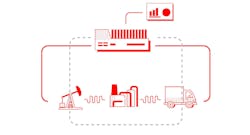IF THE AMERICAN PEOPLE wanted change in the coming year, that's what they will get with the election of Donald J. Trump as President. For better or for worse, we suspect that things will be different in the next four years than they were under President Obama. If oil and gas companies want higher revenues and profitability in 2017, that may or may not be what they will get. Energy industry analysts and consultants hold a wide range of views with regard to the coming year and beyond.
Here is a summary of what several of them have said about the outlook for 2017:
- "The industry has a good chance of achieving double-digit returns in 2017. Smarter portfolio choices and lower costs are already paying off." - Dr. Andrew Latham, VP of exploration at Wood Mackenzie
- "Rystad Energy expects that global liquid production will remain at current levels into 2017. At the same time, demand is expected to grow by around 1.3 million barrels per day. This means that the large amount of stored oil will decline considerably in 2017." - Espen Erlingsen, Rystad Energy.
- "The global oil and gas industry will continue to struggle under the weight of high debt levels in the coming year, even as the industry rebounds from its 2016 trough." - Steve Wood, Moody's oil and gas team
- "Uncertainty continues to foster angst, and recovery across the energy continuum will be delayed. Oil and gas balances may tighten more acutely later in 2017, but prices will remain in a tighter range for longer. In addition, anxiety fostered by OPEC's ambiguous arrangement to scale back volume, persistent global petroleum product imbalances, and potential for US E&Ps to reintroduce drilling activity will drive the narrative next year. Capital markets have welcomed M&A activity, yet access has inflated asset values." - Vincent Piazza, Bloomberg Intelligence
- "Many in the world of energy are looking to the OPEC cuts for price stability to gain confidence in future project investment. In North America, a large fragmented group of operators do not have the time or money to focus on global supply cuts or temporary oil price improvements." - Andrew Meyers, Douglas-Westwood
As ever, the devil is in the details. Therefore, here is some elaboration on the aforementioned comments:
WOOD MACKENZIE
Wood Mac says the industry has cut exploration deeper than other upstream spending. It's share of upstream investment will dip to a new low of just 8% in 2017. A return to historic norms will depend on oil price recovery.
Tom Ellacott, senior VP of corporate analysis research at WM, said, "Most oil and gas companies will start 2017 on a firmer footing, having halved cash flow breakevens to survive the last two years." He adds, "Overall, 2017 will be a year of stability and opportunity for oil and gas companies in positions of financial strength. More players will look at opportunities to adapt and grow their portfolios."
RYSTAD ENERGY
Shale production will grow significantly from 2018, with a yearly addition of 1 million bbl/d, while offshore will see a production decline from 2018, says Rystad. Both shale and OPEC production will play an important role in making sure that enough oil will flow to the market over the next year. Offshore sanctioning activity is at its lowest since the 1970s, and the effect of this will become increasingly visible, with a long-term decline in the non-OPEC, non-shale production expected.
BLOOMBERG INTELLIGENCE
US E&P spending by Continental, Concho, and others will be restrained, but volume will be more resilient in 2017. An explicit OPEC accord will place a floor under oil prices. Credit availability has improved, but hedging at lower prices will be a challenge. Winter heating demand will drive gas balances. Globally, although demand may have healed, the pace is unsteady.
DOUGLAS-WESTWOOD
The focus for operators is now largely concentrated on completions for cost savings and improved production. Well architecture changes, such as longer laterals, increased sand loading, and alternate material usage for savings has improved well NPVs by as much as 50% or more in some cases. One trend that has taken hold is the cost advantage of using less expensive regional sands that are highly abundant and geographically advantaged to wellsites, specifically in Texas. Such economic improvements would also be positive news for the 3,000-plus inventory of drilling but uncompleted wells (DUCs). The Permian Basin has the largest inventory of DUCs and can benefit from the improved well designs and locally sourced proppants. While the OPEC-provoked oil price increase is warmly welcomed, companies would rather focus on what they can control.
MOODY'S
Oil and gas prices are improving from 2016's lows, and commodity price hedging is increasing. Combined with reduced drilling and service costs, we expect EBITDA to grow 20% to 30% for exploration and production firms in the coming year.
Moody's outlook for the E&P sector is positive, but the rating agency's negative outlook for drilling and oilfield services companies reflects its expectation that the sector will see EBITDA decline to very low levels through early 2017 before increasing by 4% to 6%.
For midstream and MLPs, Moody's outlook is stable. Lower E&P spending has extended into midstream, flattening EBITDA growth to less than 5% and making creeping debt levels difficult to address.
The agency's outlook for the refining and marketing sector is likewise negative.


